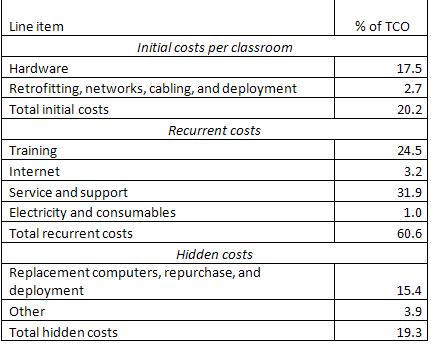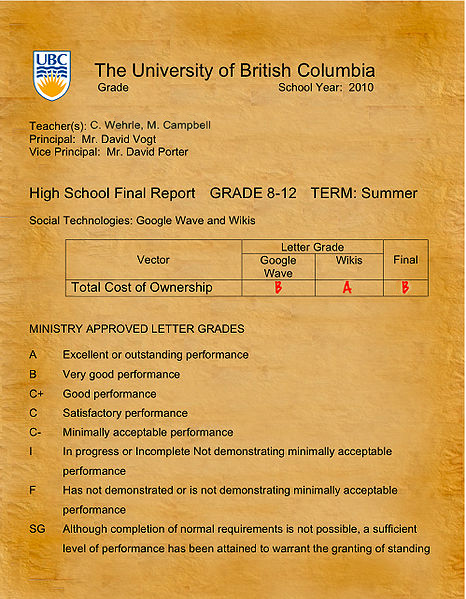Course:ETEC522/2010ST1/SocialTechnologies/Total Cost of Ownership
Total Cost of Ownership (TCO) of social technologies is a calculation to help consumers & managers assess costs, both direct & indirect, as well as any benefits related to investing in social technologies. The goal of TCO is to determine a financial figure that reflects all costs of a purchase whether big or small, hidden or otherwise. Costs associated with the investment of social technologies include service and support, networking, security, user training, & software licensing, etc.
Once the TCO is determined it must be compared to Total Benefits of Ownership (TBO) to determine whether the product is worth investing in in order to get the best Return On Investment (ROI) . This is the financial benefits from investing in social technologies. There are many ways to compute the ROI and the intangibles are sometimes most important, but also the most difficult to quantify because they are often long term and integrated with other purchases.
How Is the TCO of Social Technologies Determined?
There are several factors involved in determining the TCO of social technologies for educational institutions. The first thing one must look at is the percentage of the institution’s overall budget dedicated to technology. James MacDonald, deputy head and former IT Coordinator of Yokohama International School, states an educational institution’s IT budget should be 5-7% of its overall budget (MacDonald, 2009).
Zucker & Light (2009) would distribute that money in the following way for a smart classroom:

Of course every institution will need to adjust these percentages and line items to fit their own needs when purchasing social technologies, but this chart serves as a reference point for determining TCO. How much of each of these percentages are social technologies going to take up from the budget?
When determining the TCO for social technologies institutions will have to pay particular attention to:
- Integration of platform to support new social technologies with current IT network structure
- Increased staff (both technical and editorial) to build and maintain the platform and design the site
- Increased infrastructure (servers, storage, bandwidth, etc.)
- Utility and maintenance (biggest cost for using Google Wave)
- Increased Electricity
What Are The Issues Associated With Social Technology TCO?
It is very difficult to generalize cost structure across institutions for the following reasons (Bates, 2000):
- There is no definitive costing structure - Different institutions may view costs differently.
- Each social technology will result in a different TCO due to different fixed and variable costs.
- How social technologies are used may vary – Is the technology going to be used in a blended learning situation or in a full e-learning/distance education situation? The cost of these vary considerably.
- The time spent developing, administering, and supporting the use of the technology is difficult to gauge – Salaried professionals who do these tasks also perform other duties.
- The social technology may be shared between different functional units.
- It is difficult to determine indirect and overhead costs.
Determining the TCO for Wikis and Google Wave
The issues related to the TCO of social technologies will be illustrated using Wikis and Google Wave as examples:
| Google Wave - by Monica Campbell | Wikis - by Craig Wehrle | |
| Infrastructure |
|
1) Design, Create & Host, Your Own Wiki - Costs vary with each registrar - can get it for as little as $4.95 (U.S)/Year but must be careful because prices vary and a lot of hidden fees - Can be as high as $100/Year - Yearly renewal fees - Names that end with a country’s two letter national suffix may cost more 2) Wiki is Hosted By Outside Server & School Administers It |
| Set-up, Support & Administration |
|
How much time and effort must be paid out to an employee/employees to monitor the safety, create user groups, add, delete & manage users, create pages, etc.? If you look at the set up of this module as an example you can see Jeff Miller worked on Module four`s wiki pages for 5 days during the Month of May. He made an average of ten changes each time and spent an average of about 49 minutes on the wiki each time (averaging the time between the first saved change to the last saved change for each day). While this is probably a lower figure than reality it does allow us a starting point to think about how much time an administrator would spend on the technology. |
| Training | Navigating in Google Wave does not require scholastic training besides thousand of online videos are available to coach users how to successfully and effectively navigate their way in the programme.
Training would include navigating, clicking, dragging, editing searching, embedding, and use of keyboard-keyboarding skills, interacting and interfacing with people in cyberspace. In addition to free video training Google also hosts advance training at a cost to participants who have interests in becoming more technically adept. Click for full agenda and details and here for Click here to Book this course and here for Google Seminars for Success |
1. A member of the staff trains colleagues – salary of employees must be factored in. Is the service part of their job or is it extra work requiring extra salary? 2. Informal professional development - could be encouraged so teachers help and learn from one another in an informal way. Zhao & Frank (2003) claim that this informal method of training is more effective but determining the true TCO may be more difficult. 3. Training is outsourced – much more expensive |
| Depreciation |
|
|
| Intangibles |
|
|
NOTE: Although social technology developers want consumers hooked on using social tools to help them provide competition, increase awareness of the product brand and to capture the market and increase their market value, these developers reward consumers with free use of the product or usage at minimal cost.
Report Card Rating

Overall wikis and Wave have a good TCO because the cost of the line items are quite low when you consider what they can accomplish educationally. The goal in today`s education is to have students construct knowledge together and work collaboratively, and technologies such as wikis and Wave assist with these goals. To use them are quite easy and requires little training for the students and teachers. The overhead costs are quite low with extra storage being the one of the biggest individualized hardware expense. Other overhead costs are bundled in with other technology purchases.
The biggest costs, overall, are going to be administration, teaching and technological support of the wiki site, but this can also be bundled in salaries and time for labour of other technologies and duties, so the gauging the full TCO of these items will differ for each organization (Bates, 2000).
Another consideration is the fact it is much easier to identify costs of delivering teaching entirely at a distance through new technologies because it can be isolated as a separate activity, but it is much more difficult to calculate cost of using technology to support regular classroom teaching because integrated with other costs (Bates, 2000). Having said that, the educational benefits of wikis and Wave make the overall costs worth it for institutions that are serious about teaching using modern strategies and philosophies.
Discussion Question
Based on the examples of Wikis and Google Wave is the total cost of ownership (TCO) of social technologies low enough to get a good return on investment (ROI)?
Related Videos
Here are more videos that explain TCO of technology:
The first one explains Social Media`s ROI, in this case Return On Influence. Although this video is intended for a profit making company, the concepts described can be useful when deciding TCO of social technologies for educational institutions. If one social technology has a better ROI than another that would help decide whether the TCO is worth the investment or not.
The second video demonstrates how a company defines the TCO for basic Network Cabling. This is useful to help illustrate how the concepts outlined above are determined for a profit making company. The concepts can be applied to any technology for any institution.
External Resources and References
Apple Inc. (n.d.). Wiki setup overview. Retrieved from http://docs.info.apple.com/article.html?path=ServerAdmin/10.5/en/c4ws5.html
Bates, Tony. (2000). Managing technological change. Jossey-Bass Inc Pub.
MacDonald, J. (2009). Personal Interview. Retrieved from http://economicsofedtech511.pbworks.com/Reading-1%3A-The-Economics-Of-Educational-Technology
Pruszko, C. Setting up a free web or wiki server – at home, in school, and on the internet [PDF document]. Retrieved from Lecture Notes Online Web site: http://eroosevelths.pgcps.org/pruszko/PUWTWebWikiServer%20handout.pdf
Zhao, Y. & Frank, K. (2003). Factors affecting technology uses in schools: An ecological perspective. American Educational Research Journal, 40(4), 807-840.
Zucker, A.A. & Light, D. (2009). Laptop programs for students. Science Mag, 323, 82-85. Retrieved from http://www.idrc.ca/uploads/userS/12381700641Zucker_and_Light_2009.pdf